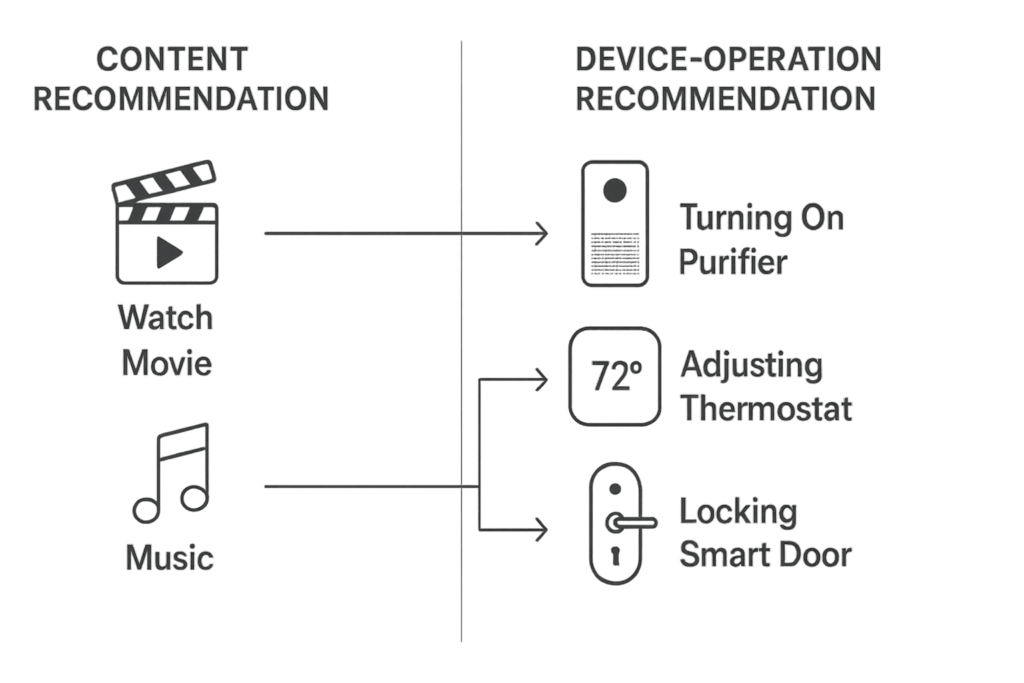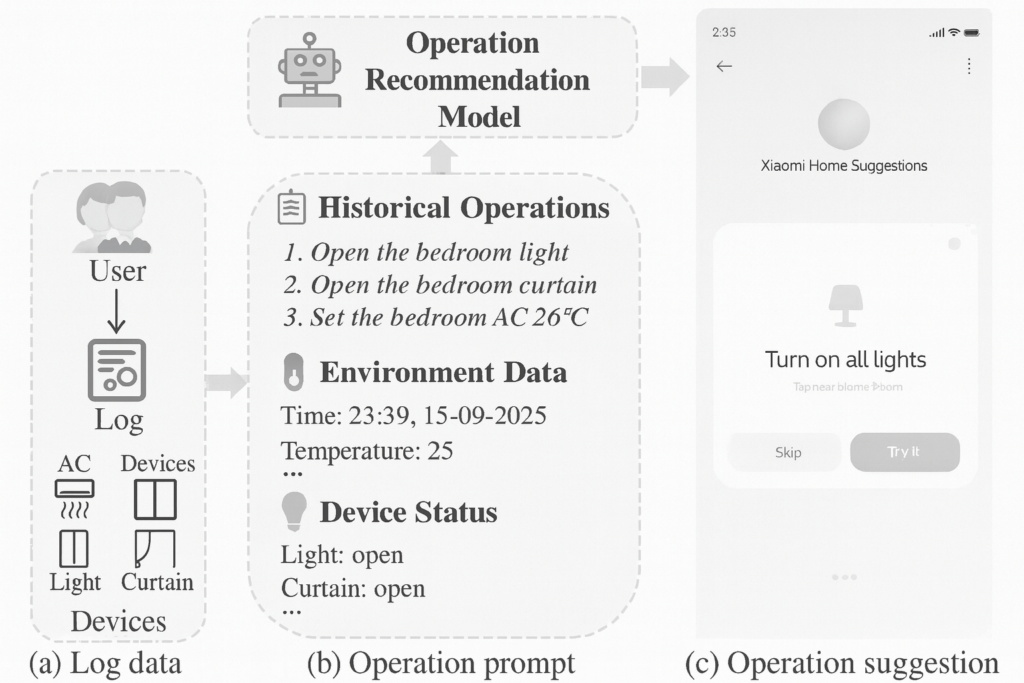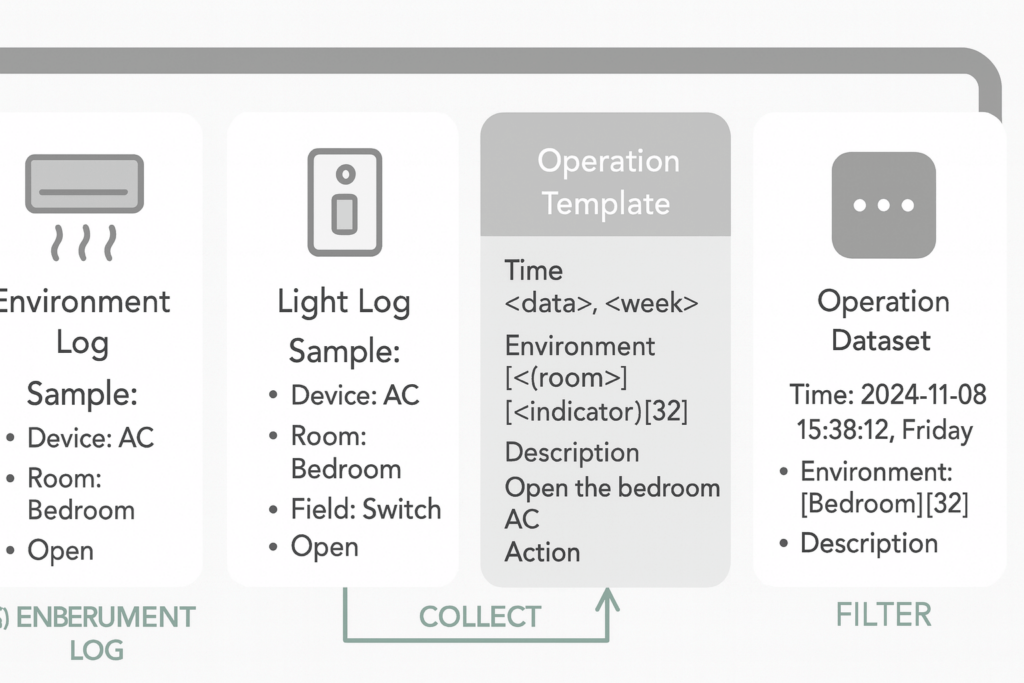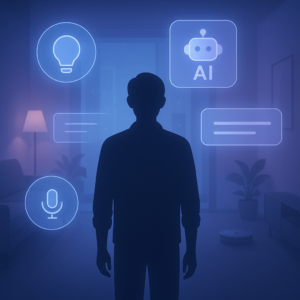AI & IoT: Shaping the Future of Smart Home Automation
A clear, accessible look at how modern AI models are learning to predict and recommend the right actions for your smart home devices — marking the next era of IoT automation.

Why Smart Homes Need Better Recommendations
Households in the United States now install more connected devices each year. A typical home controls lights, plugs, cameras, thermostats, vacuums, air sensors, purifiers, speakers, and several small appliances. Each device ships with its own app, its own settings, and its own alerts. People switch between them many times a day, and the system becomes hard to manage.
The Core Problem for the User
Devices run at different times. Automations overlap. A light turns on with no clear reason. A purifier runs longer than needed. A camera sends alerts during a quiet hour. Users do not see the whole picture, so they cannot fix these issues. The home feels less “smart” and more like a set of disconnected gadgets.
A Simple Fix: AI Recommendations
The arXiv paper explains a shift from content suggestions to device-operation recommendations. The system studies real activity inside the home. It detects routines by watching patterns and then proposes small changes. These suggestions guide the user instead of forcing rules. The home becomes easier to manage, and the user stays in control.
Example: Xiaomi Home
Xiaomi Home offers a clear model. It shows real-time states for all devices and offers context prompts based on sensor data. The app may suggest lowering light levels, pausing a robot vacuum, or changing air-purifier modes. The user sees short, direct options that fit the moment. This reduces friction and builds trust in automation.
What a “Device-Operation Recommendation” Means

A device-operation recommendation is a suggestion that tells a smart device what action to take next. The system studies past activity, current context, and live device states. It checks sensor history, room conditions, user habits, and timing. Then it predicts which action improves comfort or safety. An example is a prompt to raise air-purifier power when indoor quality changes or to stop a robot vacuum during quiet hours.
How This Differs from Common Recommenders
Standard recommendation engines focus on content. They choose movies, products, or songs. These items do not change the user’s environment. A device-operation recommendation affects the home in real time. It turns something on or off. It changes a room’s temperature, sound, or light. This makes the decision more sensitive because the wrong action can disturb the user or conflict with other devices.
Key Challenges in Operation Recommendations
1. Action Logic Across Devices
Smart homes contain many devices, each with its own rules. Lights, cleaners, sensors, and outlets follow different modes. The system must understand how actions interact. If two rules collide, the user sees strange behavior. The paper stresses that wrong logic increases confusion.
2. User Preferences and Routines
The system must learn quiet hours, sleep schedules, cleaning habits, and tolerance for alerts. These patterns differ across households. A suggestion that works for one family may frustrate another.
3. Risk of Poor or Unsafe Suggestions
The paper warns about the risk of inappropriate recommendations. A bad suggestion can waste energy or interrupt daily life. It can create noise, change light levels, or produce privacy concerns. This is harder than content ranking because physical actions have real effects.
DevPiolt Architecture: Four Linked Modules

The paper presents DevPiolt as an end-to-end framework for operation recommendation in smart homes. It connects four modules:
- Pre-training on raw operation history.
- Fine-tuning on a labeled operation corpus.
- Recommendation Refinement with Direct Preference Optimization (DPO).
- Confidence-based Exposure Control that decides when to show a suggestion.
Figure 3 in the paper gives a clear high-level diagram of this pipeline. You can reuse that figure as the main architecture illustration for the article, or redraw it as a simplified block scheme for a US smart home platform.
Pre-training: Learning Device Patterns From History
The pre-training stage feeds a large stream of historical IoT operations into a base LLM. Each record combines:
- Time and day.
- Environment readings, such as room temperature and humidity.
- The executed device action for a specific IoT device.
The team converts each operation sequence into text and trains the model on a next-action prediction task. The model sees several past operations plus the current context and then predicts the next operation.
Through this, the model learns:
- Which device actions are legal.
- Valid value ranges, such as a sensible AC temperature.
- Basic operation logic, like turning on a power outlet before starting an AC.
To keep broad knowledge about language and general topics, the authors mix the operation corpus with a general text corpus in a 1:1 ratio. This helps the model stay fluent when it later generates short natural language hints for the user inside a smart home app.
Fine-tuning: From Raw Actions to User-Facing Suggestions
Pre-training gives DevPiolt basic domain knowledge, but it still needs to produce useful recommendation prompts for real users. The fine-tuning stage trains on about 15,000 manually annotated samples.
Each sample includes:
- Operation history for a user (without the final action).
- Current time and environment.
- The list of available IoT devices in that home.
- The ground-truth action to take.
- A short text description like “Turn on the bedroom AC and set it to 24 °C”.
Fine-tuning has two concrete goals:
- Generate valid operation actions only for devices that are present.
- Generate clear text that explains the action to the user.
The authors tested two strategies. Generating text and action at the same time worked poorly. The final design is action-first:
- Predict the structured operation quadruple (device, field, operator, value).
- Then generate the natural language description based on that action.
This action-first path fits smart home control well. The system locks in a correct and safe IoT operation, then explains it in user-friendly text inside Xiaomi Home or similar apps in the US market.
Recommendation Refinement: DPO on User Preferences
Even after pre-training and fine-tuning, the model can still miss subtle user preferences. For example, many users dislike curtain actions at midday or reject an AC suggestion that conflicts with a recent manual change.
The Recommendation Refinement module applies Direct Preference Optimization (DPO). The team builds a preference dataset from about 9,000 user interactions collected over two weeks. Each record becomes a pair:
- Positive sample: the prompt plus the action the user actually executed.
- Negative sample: the same prompt plus a dispreferred action.
Negative actions come from two clear patterns:
- Time-sensitive rejection: actions that do not match the user’s behavior within a ±1 hour window.
- Conflicting operations: actions that flip a device state soon after the user changed it, such as turning the AC on right after the user turned it off.
DPO training adjusts the model so that it assigns higher probability to positive samples and lower probability to negative ones. No separate reward model is needed. The result is a recommender that respects household routines and avoids annoying, out-of-context smart home suggestions.
Confidence-based Exposure Control: When to Show a Suggestion
Even a strong model will generate low-quality IoT operation recommendations in some edge cases. Since these actions change the physical environment, a bad suggestion harms trust more than a weak movie recommendation.
The confidence-based exposure control module solves this for Xiaomi Home:
- The model computes a confidence score for each recommended operation.
- The score uses the predicted probabilities of key attributes, such as device, field, and value (for example [AC][temperature][24]).
- A weighted scheme averages these probabilities across all actions in the recommendation.
A suggestion appears in the app only if its confidence score crosses a threshold. The system also:
- Lowers the threshold for harder tasks, such as predictions with a large device pool or continuous numeric values.
- Uses a cascade rule that drops a whole recommendation if top-level attributes, such as device choice, have low confidence.
- Combines the average confidence with the confidence of the first generated token, which often anchors the full prediction.
For a US smart home user, this means they see fewer prompts, but those prompts match their context much better. The model does not spam them with guesses when it feels uncertain.
How This Architecture Serves Smart Home Automation
Together, these four modules turn raw Xiaomi Home logs into trustworthy AI recommendations:
- Pre-training learns how IoT devices behave.
- Fine-tuning teaches the model to speak the user’s language and respect device availability.
- DPO refinement pulls the system toward each user’s real preferences.
- Confidence-based exposure control filters out unstable actions before they reach the screen.
This stack is a practical blueprint for any AI-powered smart home platform that wants safe, high-quality operation recommendations, not just content suggestions.
Results and Measured Effects

The authors use three core metrics to judge model quality:
Exact Match for the full operation action.
Loose Match F1 for partial correctness across device, field, operator, and value.
Rule Score for compliance with internal operation rules inside Xiaomi Home.
These metrics reflect both structural accuracy and the safety of each action.
Comparison With Baseline Models
DevPiolt outperforms GPT-4, Qwen-Plus, and the non-DPO LLM across all metrics in the paper. Exact Match rises by a clear margin because the model learns device patterns during pre-training. Loose Match F1 improves through the action-first fine-tuning design. Rule Score increases because the model avoids illegal or contradictory actions.
These gains show that device-operation prediction benefits from domain-specific data rather than general language ability alone.
Online Impact in Real Homes
The team tested DevPiolt in Xiaomi Home across more than 200 IoT devices and 32 device types. Two clear effects appeared during the online run:
The system covered a wider set of smart home devices, including appliances with complex settings.
Users accepted more operation recommendations, which raised the daily acceptance rate in real use.
The paper reports a notable rise in exposure quality because low-confidence prompts were filtered out, so each recommendation felt more relevant.
What Works and What Still Limits the System
DevPiolt succeeds by learning real operation logic, respecting device availability, and adapting to user preferences. The DPO module has strong impact because many unwanted actions come from timing mismatches or quick state flips, and these errors decrease after refinement.
The system still relies on high-quality operation logs. Homes with sparse history produce weaker patterns. The exposure module reduces noise but can hide suggestions in rare or uncertain contexts. Long-tail devices with unusual fields remain harder to model.
Even with these limits, the results show that AI-based operation recommendations can handle real smart homes with many devices and varied routines.
Practical Lessons for Smart Homes and Commerce Platforms

The study gives clear guidance for any system that plans to offer AI-based action suggestions, whether the target is a smart home, an online store, or a partner catalog.
Build Clean Data From Real History
A stable model starts with structured logs. You need operation history, environment readings, and device states. For e-commerce or a partner site, this translates to click paths, product views, stock changes, and segment signals. Each record must follow the same pattern so the model can see habits across days.
Create Strong Annotation Rules and Templates
DevPiolt performs well because the team uses consistent action templates. Each action follows a fixed structure: device, field, operator, value. For commerce, this becomes: product, action (view or add-to-cart), strength of interest, and time. A constant format makes fine-tuning easier and reduces invalid outputs.
Capture User Preferences From Feedback
User actions tell the system what the person accepts or rejects. The paper builds pairs: positive actions that users take and negative actions that they skip or reverse. In commerce, this means pairing a viewed item with an ignored alternative. In partner networks, this shows which brands or device types attract real engagement.
Control Quality Through Confidence Gates
The model should not recommend every possible action. DevPiolt uses confidence-based exposure control, which filters low-certainty actions. This reduces noise and builds trust. Commerce systems can filter low-confidence product picks the same way. Partner platforms can suppress weak cross-sell prompts so the feed feels helpful, not pushy.
Manage Risk and Respect Privacy
Operation suggestions change the user’s physical space. Poor suggestions irritate the user, and repeated prompts feel intrusive. The same risk appears in commerce, where too many product pushes damage trust. Any system must track how often prompts appear, which ones cause irritation, and whether the suggestion uses private data. The article highlights the danger of inappropriate recommendations, which applies to both home devices and commerce flows.
Future Directions and Long-Term Potential

Smart home systems grow in scale, and new forms of input appear. Cameras, air-quality stations, presence sensors, power meters, and noise monitors create multimodal data. A model that reads text and sensor patterns can react faster. A model that adds image signals from indoor cameras gains stronger context for motion, lighting, and appliance states.
Personalization Over Long Periods
Short-term signals help with small tasks, but homes have slow and stable routines. A mature system tracks seasonal habits, holiday patterns, and sleep cycles across months. These signals shape long-term preferences. The assistant then offers actions that match the household across the full year, not just the past week.
Use in Partner Stores and Gadget Aggregators
Partner shops and aggregators for smart gadgets can use the same logic. A device-action model can match buyers with the right smart plugs, sensors, robot vacuums, or air purifiers, based on past interest and the setup they already own. The platform shows fewer random items and more items tied to real device networks inside each home.
Key Challenges Ahead
Three challenges limit progress:
- Scale. Modern homes include large device sets across many brands.
- Device diversity. Each appliance family uses its own fields and value ranges.
- Sparse data. Many devices run with light usage, so patterns grow slowly.
These limits shape the next steps. Systems must merge broad device knowledge with clear safety rules, then work even in homes that generate only a small number of daily events.
Conclusion

Smart homes grow more complex each year. People use more devices, and each device adds more modes and routines. The work described in the paper shows that AI-driven operation recommendations can make these systems easier to control. The authors build a full pipeline that learns from history, adapts to preferences, and filters weak suggestions. Their results show real gains in daily use.
Readers can apply these ideas in many settings. A simple start is to introduce one or two helpful prompts inside a smart home app or a gadget catalog. Later, the system can study longer patterns and offer richer actions. Even small steps reduce user effort and raise trust in automation.
Anyone who works with IoT devices, partner feeds, or smart gadget sales can gain value. Better recommendations guide buyers, improve device use, and keep the home predictable. The core lesson is direct: begin with clean data, add careful training, and show only prompts that help the user at that moment.
This article builds on recent research in device-operation recommendation systems, particularly the DevPiolt study published on arXiv, which explores how AI models learn user behavior patterns inside large IoT ecosystems.
